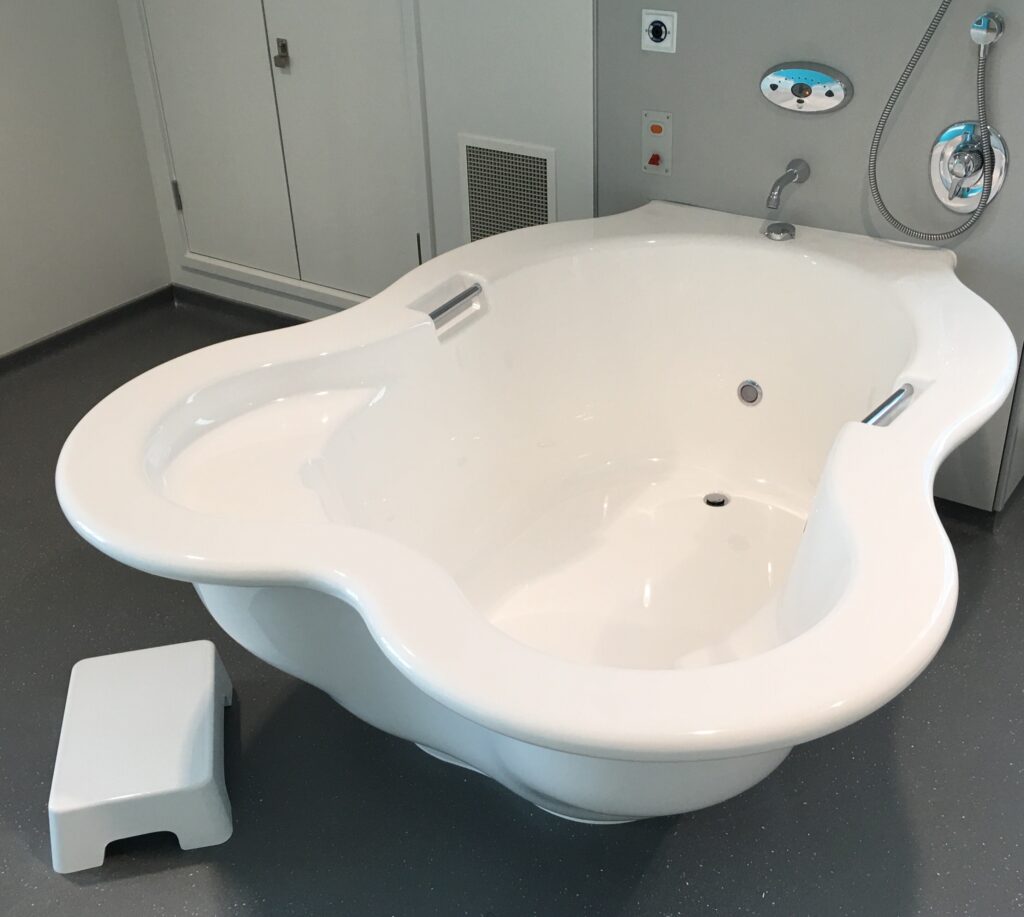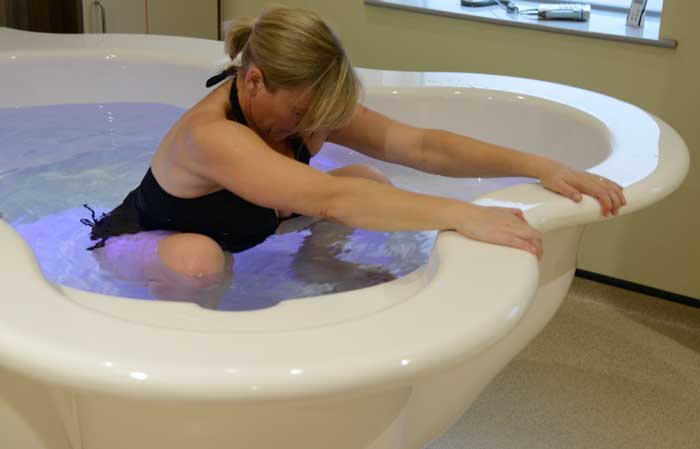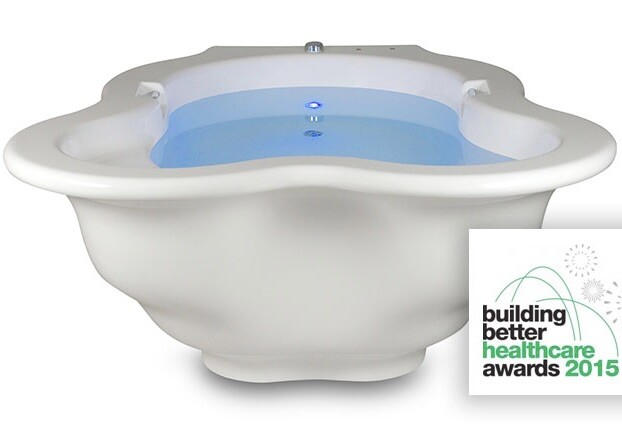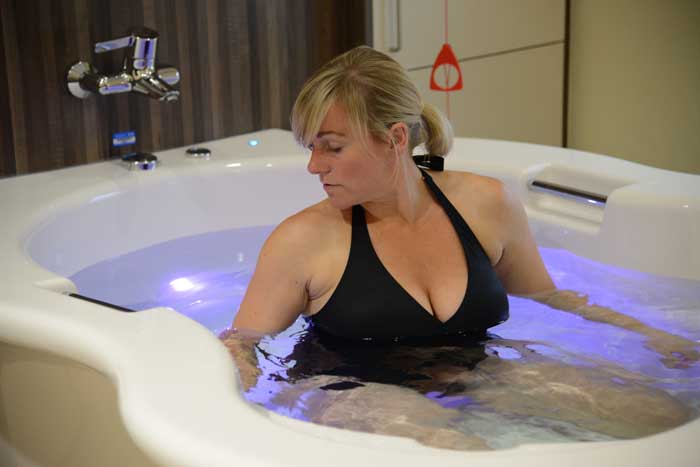Michel Odent’s groundbreaking report “Birth Under Water” that was published in the Lancet in December 1983 is widely regarded as the seminal moment in time when the use of water for labour and birth entered our consciousness.
I’d personally like to thank Michel for being the inspiration that led me to begin to create and develop water birth pools in 1987 and for facilitating the birth of my son Theo at home in 1988.
Keith Brainin – Founder & Director Active Birth Pools
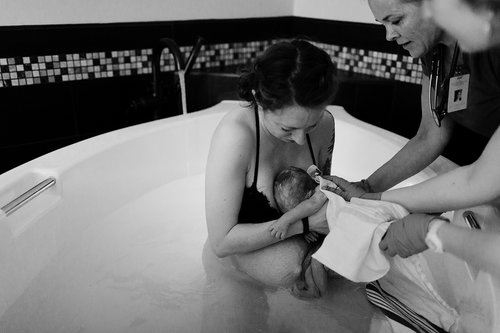
Birth under water – Michel Odent
Originally published in the Lancet: 1983
Centre Hospitalier Général de Pithiviers, PIthiviers 45300, France
The 100th birth under water in our hospital in June provided my team with an opportunity to summarise our experience of the use of water in an obstetric unit.
Since a report on birth under water in 1805,1 the subject has been rarely broached in the medical literature.
In Pithiviers, a hospital which is, in other respects, a conventional state hospital,2 a small pool has been installed close to the homely birthing room.
This pool is large enough (2m in diameter) and deep enough (about 0.7m) to make it easy for a woman in it to change her posture.
Many parturients feel and irresistible attraction to water. We don’t advise women to try the pool; we simply offer the pool as a possibility.
The water is ordinary mains tap water, at a temperature of 37 °C. The water is not sterilized, and contains no chemicals or additives on any sort.
We tend to reserve the pool for women who are experiencing especially painful contractions (lumbar pains, in particular), and where the dilation of the cervix is not progressing beyond about 5cm. In these circumstances, there is commonly a strong demand for drugs.
In most cases, the cervix becomes fully dilated within 1 or 2 hours of immersion in the pool, especially if the lights are dimmed.
It is possible to check the fetal heartbeat regularly with a small ultrasound stethoscope or with a traditional obstetrical stethoscope. Most women choose to leave the water in the second stage.
We believe that the warm pool facilitates the first stage of labour because of the reduction of the secretion of nor-adrenaline and other catecholamines; the reduction of sensory stimulation when the ears are under water; the reduction of the effects of gravity; the alteration of nervous conduction; the direct muscular stretching action; and peripheral vascular action.
Other factors, however, are difficult to rationalise. We have found, for example, that the mere sight of water and the sound of it filling the pool are sometimes sufficient stimuli to release inhibitions so that a birth may occur before the pool is full.
We have observed that water seems to help many parturients reach a certain state of consciousness where they become indifferent to what is going on around them.
Although nearly all the women who enter the pool leave it before birth, the process of delivery can sometimes be so extraordinarily fast under water, that some parturients do not leave the pool at the second stage.
Birth under water is therefore not exceptional in our unit, although it may not be intentional. During the second stage, immersion in warm water seems to help women to lose inhibitions. Most women cry out freely during the last contractions.
When the birth happens under water, the newborn infant is brought gently to the surface and placed in the mother’s arms. This is always done within seconds but without rushing (I am present at the pool for every underwater delivery).
Our experience confirms that the newborn’s first breathing is triggered by contact with the air and the sudden difference in temperature.
There is no risk of inhalation of water. It is useful to remember that in the human species carotid chemoreceptors are thought to be insensitive at birth, and very likely play no part at the time of the first cry. 3,4,5 Only 2 newborn infants out of 100 needed suction of the upper respiratory tract and a short period of manual ventilatory support.
At the time of first contact, most mothers are in a vertical position, kneeling in the water. They hold the baby in their arms in such a way that skin-to-skin and eye-to-eye contact are as perfect as possible.
An early demonstration of the rooting reflex is almost the rule, and a first sucking 20 min after the birth is common.
Water seems to facilitate the development of the mother-infant relationship. We cut the umbilical cord and help the mother leave the pool just before expulsion of the placenta.
We consider that there might be a risk of water embolism if the mother were to stay in the pool after this time. In 100 underwater deliveries there were 2 manual removals of placenta (our general rate is less than 1%).
All the presentations were cephalic. In breech presentations, our strategy is to use the first stage as a test before deciding on either a vaginal delivery or a caesarian section: in these cases we prefer not to interfere with drugs or with a bath.
Among the 100 women who gave birth underwater, there were 43 primipara, 37 secundiparas, 14 para 3, 2 para 4, one para 5, one para 6, and one para 7.
The youngest was 19 and the oldest was 43. The average age was 28. The lowest birth weight was 2.15kg and the highest was 4.40 kg, we did not perform any episiotomies.
All the tears (of which there were 29) were first degree. We had no infectious complications, even where the membranes were already broken.
There were no perinatal deaths. One infant was transferred to a paediatric unit one day after the birth with groaning and respiratory failure, symptoms which were diagnosed as subarachnoid haemorrhage after delivery in the posterior position at 37 weeks.
Only one infant was jaundiced and required phototherapy (15mg/dl bilirubin on the second day). One of the infants born under water died suddenly some weeks later, although it was previously considered to be perfectly healthy.
We have found no risk attached either to labour or to birth under water, and in any hospital where a pool is in daily use, a birth under water is bound to happen now and then.
Compared with the supported squatting position in the birthing room, we have found that the end of the second stage of labour can be more difficult under water, particularly for primipara, but immersion during the second half of the first stage of labour is helpful, particularly for parturients having painful and insufficient contractions.
It should be possible for any conventional hospital to have a pool situated close to the birthing room and operating theatre.
The use of warm water during labour requires further research, but we hope that other experience would confirm that immersion in warm water is an efficient, easy, and economical way to reduce the use of drugs and the rate of intervention in parturition.

REFERENCES
1. Embry M. Observation sur un accouchement terminé dans le bain. Ann Soc Méd Prat Montpellier 1805; 5: 13.
2. Gillett J. Chilbirth in Pithiviers, France. Lancet 1979; ii: 894-96.
3. Girard F, Lacaisse A, Dejours P. Lestimulus O 2 ventilatoire à la période néonatale chez l’homme. J Physiol (Paris) 1960; 52: 108-09.
4. Purves MJ. The effects of hypoxia in the newborn lamb before and after denervation of the carotid chemoreceptors. J Physiol 1966; 185: 60-77.
5. Purves MJ. Chemoreceptors and their reflexes with special reference to the fetus and newborn. J Devl Physiol 1981; 3: 21-57.


